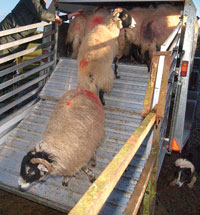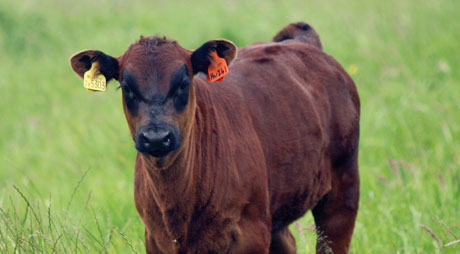Don’t breach record-keeping rules

It’s a fact of life, where there is farming there is record-keeping. But a missed entry in the movement book or failure to report the death of an animal can cost a farmer dearly when it comes to a Rural Payments Agency inspection.
Although inspectors try to give farmers 48 hours notice of their arrival, they can turn up unannounced, so it’s vital all records are maintained to a high standard.
Farmers are continuing to fail cross-compliance inspections due to breaches in livestock ID and record-keeping rules, costing them in lost payments from the Single Payment Scheme, reminds Simon Draper, adviser for the Momenta cross-compliance programme run by AEA. “We urge all cattle and sheep keepers to familiarise themselves with the legal requirements to avoid unnecessary reductions in their payments. There is a lot of guidance available and Momenta offers a confidential helpline service for anyone still unsure about their obligations.”
Records show that out of the 10% of cattle keepers and 3% of sheep and goat keepers who are selected by the RPA solely for identification and record-keeping inspections, the biggest single failure is that of not informing British Cattle Movement Service of cattle movements.
Farmers should be prepared for a possible inspection and bear in mind what the inspectors will be looking for, says Barrie Stedman, head of inspectorate at RPA.
“First, for a cattle inspection, we inspect the herd record book to make sure that appropriate records are being kept. For each beast on the farm we will want to see the ear-tag number, dam’s ear-tag number, date of birth and sex, date and details of movements on and off your holding, breed and date of death recorded.

“Next, we’ll have a look at every animal in the herd. We need to check that ear-tag numbers and the physical characteristics of each animal recorded in its passport actually match the animal itself. Finally, we’ll ensure that every animal has its own passport, and vice versa, and make sure that unused ear-tags are stored properly.”
With added time pressures, some farmers prefer to use CTS online or a farm software package to register births and movements online as it’s quicker and keepers receive a confirmation straight away, adds Mr Stedman.
Cross-compliance Statutory Management Requirements (SMR) 7, 8 and 8a outline the rules for cattle, sheep and goat identification and record-keeping and RPA is keen to remind keepers of their legal obligations for the following common breaches:
Failure to report death of an animal

If cattle under 24 months old die on a farmer’s holding, the keeper must notify the death by returning their passports to BCMS within seven days. When cattle over 24 months old die, the farmer must phone the TSE helpline to have the animal taken away and give the appropriate identification documents to the collector. In both instances the keeper must record the death in the farm register within seven days.
Movement records
When cattle are moved on to or off a farmer’s holding or to or from the market, for example to the slaughterhouse, the keeper must notify the movement to BCMS and record it in the farm register within three days.
Lost tags
Cattle and sheep tags which are lost or difficult to read must be replaced within 28 days of the loss/illegibility being noticed.
Livestock keepers are encouraged to familiarise themselves with the SMRs to avoid having payments reduced, adds Mr Stedman.
“Dairy farmers must fit one ear-tag within 36 hours and a second tag within 20 days of the calf’s birth. Beef farmers must fit both tags within 20 days of the calf’s birth except in the case of bison, which must be tagged within nine months of age. However, in all cases cattle must be double tagged before they move off the holding.
“All calves with the exception of bison must be registered with BCMS within 27 days of birth. bison must be registered within seven,” he says.
“All cattle moved off/on to holdings must be accompanied by a valid passport and BCMS must be notified of the movement within three days. BCMS must also be informed of any cattle deaths on the holding/missing animals within seven days.”
It’s vital that full herd records must be maintained, he adds.
And it’s not just cattle producers that have to follow similar rules and regulations, Mr Stedman says.
“Sheep checks include full inspections of flock records and AML1 movement documents, physical inspection of all animals as well as eartag inspections of a 60-animal sample. Unused ear-tags are checked to ensure that they are properly stored.”
Sheep and goats must be tagged before the age of nine months, or six months if they are housed overnight. If animals leave their holding of birth (for any reason) before these ages, they must also be tagged.
Those animals intended for slaughter in the UK before they reach 12 months of age only require one tag, but all other animals require either a tag and a tattoo or two identical tags. Two tags are required for animals of any age being exported.
Those animals imported from outside the EU should be tagged within 14 days of arrival and before leaving the holding of import.
Farmers should double-tag animals born before February 2003 with identical UK tags if they are still on the holding of birth, or two non-identical R tags if they are not.
As with cattle records, full flock records must be maintained and must include an annual inventory count for sheep and goats present on a holding on 1 December each year.
When moving sheep and goats farmers should be reminded of the following points:
• They must be correctly tagged and the movement should be recorded in the flock register.
• A movement document (AML1) must be completed, and it is the responsibility of the recipient of the sheep, who may be a new or the existing keeper, to complete the form and send off to the local authority.
• Bringing unsold animals back from market constitutes a movement and so in such circumstances an AML1 must be completed and sent off.
